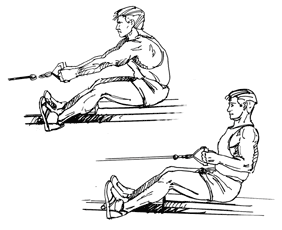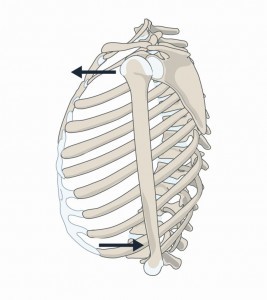
Some examples of exercises where I see poor technique include cable rows, dumbbell rows, and most commonly bodyweight rows with straps like the TRX. While these are all terrific movements for strengthening the postural muscles of the upper back, we need to start taking a closer look at what’s going on around the shoulder complex to make sure we are performing these movements as efficiently and safely as possible. While none of these flaws put the individual in a dangerous position, it is still important that we establish better habits with posture in certain exercises that are going to have a direct carryover to other movements and daily activities. While I won't cover all the mistakes, I will discuss the most common ones that I see on a daily basis.
1) Shrugging the shoulders because of upper trap dominance
2) Using the biceps to “pull” the weight instead of the upper back
3) Extending at the low back to substitute for lack of mobility in the upper back
4) Flexing the wrist to gain extra range of motion
5) Anterior humeral glide
The most common mistake I see is
scapular elevation which is the tendency to shrug or hike the shoulders up while performing a row. This usually means that the Upper Traps are overactive and we are having trouble activating the muscles that are responsible for scapular retraction and depression because they are weak or inhibited or because of
poor posture. A great tip is to cue the individual to "wrap their shoulder blades around their rib cage". While it's easy to tell the person to "pinch their shoulder blades back and down" this cue may lead to more stability but at the expense of mobility. The "wrap" cue promotes stability but with better balance of muscular activation and motion at the shoulder.
 Humeral Anterior Glide
Humeral Anterior Glide - What we see here is the front of the shoulder tend to glide forward while performing this movement pattern. This may happen because we have poor scapular movement on our ribcage yet our humerus continues to move on the socket into extension. What we get is an aggressive pull of the humerus past the midline of our body which can lead to a loose
anterior shoulder capsule. This can eventually lead to some pathologies such as anterior inpingement, bieceps tendonitis, and even labral tears. We need to instruct these individuals to limit their end-range of motion and to not pull their elbows so far past the midline of the body. These individuals need to improve their tissue quality as well as mobility in the posterior shoulder.
Keeping a neutral head and lumbar position. Keep the chin tucked and the neck packed. There is no need for forward head posture. The same goes for the lumbar spine. Just like with overhead pressing, we will start to compensate for lack of movement in the thoracic spine with extension in our lumbar spine. Refer back to number 1. Try and keep the lower back in a more neutral position especially when fatigue starts to set in. If we allow ourselves to fall into excessive lumber extension we will also lose movement at the thoracic spine. When performing a standing cable row, keep the rib cage down and one hand on your stomach. I find this puts people in a better position.
The next time you perform any sort of rowing variation pay more attention to your posture. Set your core, be aware of how much lumbar extension you are in and really focus on getting good scapular retraction. You will be surprised at how much carryover this has to other movements you will perform in the gym!
About ptguy76
Trainer. Writer. Designer. Handyman.
 Some examples of exercises where I see poor technique include cable rows, dumbbell rows, and most commonly bodyweight rows with straps like the TRX. While these are all terrific movements for strengthening the postural muscles of the upper back, we need to start taking a closer look at what’s going on around the shoulder complex to make sure we are performing these movements as efficiently and safely as possible. While none of these flaws put the individual in a dangerous position, it is still important that we establish better habits with posture in certain exercises that are going to have a direct carryover to other movements and daily activities. While I won't cover all the mistakes, I will discuss the most common ones that I see on a daily basis.
Some examples of exercises where I see poor technique include cable rows, dumbbell rows, and most commonly bodyweight rows with straps like the TRX. While these are all terrific movements for strengthening the postural muscles of the upper back, we need to start taking a closer look at what’s going on around the shoulder complex to make sure we are performing these movements as efficiently and safely as possible. While none of these flaws put the individual in a dangerous position, it is still important that we establish better habits with posture in certain exercises that are going to have a direct carryover to other movements and daily activities. While I won't cover all the mistakes, I will discuss the most common ones that I see on a daily basis.
 Humeral Anterior Glide - What we see here is the front of the shoulder tend to glide forward while performing this movement pattern. This may happen because we have poor scapular movement on our ribcage yet our humerus continues to move on the socket into extension. What we get is an aggressive pull of the humerus past the midline of our body which can lead to a loose anterior shoulder capsule. This can eventually lead to some pathologies such as anterior inpingement, bieceps tendonitis, and even labral tears. We need to instruct these individuals to limit their end-range of motion and to not pull their elbows so far past the midline of the body. These individuals need to improve their tissue quality as well as mobility in the posterior shoulder.
Keeping a neutral head and lumbar position. Keep the chin tucked and the neck packed. There is no need for forward head posture. The same goes for the lumbar spine. Just like with overhead pressing, we will start to compensate for lack of movement in the thoracic spine with extension in our lumbar spine. Refer back to number 1. Try and keep the lower back in a more neutral position especially when fatigue starts to set in. If we allow ourselves to fall into excessive lumber extension we will also lose movement at the thoracic spine. When performing a standing cable row, keep the rib cage down and one hand on your stomach. I find this puts people in a better position.
The next time you perform any sort of rowing variation pay more attention to your posture. Set your core, be aware of how much lumbar extension you are in and really focus on getting good scapular retraction. You will be surprised at how much carryover this has to other movements you will perform in the gym!
Humeral Anterior Glide - What we see here is the front of the shoulder tend to glide forward while performing this movement pattern. This may happen because we have poor scapular movement on our ribcage yet our humerus continues to move on the socket into extension. What we get is an aggressive pull of the humerus past the midline of our body which can lead to a loose anterior shoulder capsule. This can eventually lead to some pathologies such as anterior inpingement, bieceps tendonitis, and even labral tears. We need to instruct these individuals to limit their end-range of motion and to not pull their elbows so far past the midline of the body. These individuals need to improve their tissue quality as well as mobility in the posterior shoulder.
Keeping a neutral head and lumbar position. Keep the chin tucked and the neck packed. There is no need for forward head posture. The same goes for the lumbar spine. Just like with overhead pressing, we will start to compensate for lack of movement in the thoracic spine with extension in our lumbar spine. Refer back to number 1. Try and keep the lower back in a more neutral position especially when fatigue starts to set in. If we allow ourselves to fall into excessive lumber extension we will also lose movement at the thoracic spine. When performing a standing cable row, keep the rib cage down and one hand on your stomach. I find this puts people in a better position.
The next time you perform any sort of rowing variation pay more attention to your posture. Set your core, be aware of how much lumbar extension you are in and really focus on getting good scapular retraction. You will be surprised at how much carryover this has to other movements you will perform in the gym!
